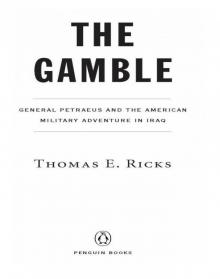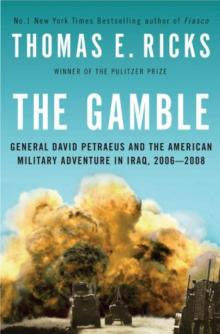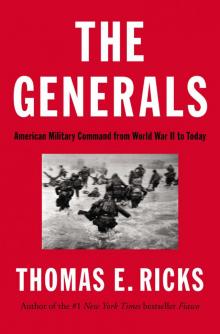- Home
- Thomas E. Ricks
The Gamble: General Petraeus and the American Military Adventure in Iraq
The Gamble: General Petraeus and the American Military Adventure in Iraq Read online
Table of Contents
ABOUT THE AUTHOR
Title Page
Copyright Page
Dedication
PART ONE - THE OLD WAR ENDS
Chapter 1. - THINGS FALL APART
Chapter 2. - HOW TO FIGHT THIS WAR
Chapter 3. - KEANE TAKES COMMAND
Chapter 4. - A STRATEGY IS BORN
PART TWO - A NEW WAR BEGINS
Chapter 5. - IF YOU’RE SO SMART . . .
Chapter 6. - GAMBLING ON A “SHITTY HAND”
Chapter 7. - SIGNS OF LIFE IN BAGHDAD
Chapter 8. - THE DOMESTIC OPPOSITION COLLAPSES
PART THREE - WAR WITHOUT END
Chapter 9. - THE TWILIGHT ZONE
Chapter 10. - BIG WASTA
Chapter 11. - AFTER THE SURGE
Chapter 12. - OBAMA’S WAR
EPILOGUE
AFTERWORD
APPENDIXES
NOTES
Acknowledgements
INDEX
Praise for The Gamble
“In his absorbing, impressively researched new book, The Gamble, Ricks examines how U.S. goals in Iraq changed in late 2006. Through his impressive access to military and political leaders, Ricks demonstrates that what fueled this change was the lack of any recognizable progress in Iraq.”
—The Boston Globe
“[A] grim forecast . . . [by] the nation’s best-known defense correspondent.”
—Mike Allen, Politico
“It is Ricks’ look forward that gives this book its tremendous value, not the who-did-what-when chronicle of the surge.”
—Tony Capaccio, Bloomberg
“Thomas E. Ricks eavesdrops on the high-ranking squabble over The Gamble (Penguin), General Petraeus’s plan to launch the surge in Iraq.”
—Vanity Fair
“[The Gamble] suggests there may be a light at the end of the tunnel, but if there is, it’s flickering—and a long way off.”
—Time
“If you enjoyed Fiasco, thrilled to have your prejudices about the clueless Bush administration confirmed, it’s your responsibility to read The Gamble.”
—Salon.com
“Rich in both vignettes and interviews.”
—The Economist
“The principle value of Mr. Ricks’ book beyond being a historical chronicle is the light it may shed on the future course of events in Afghanistan.”
—The Washington Times
“A journalistic achievement of high order.”
—The Second Pass.com
“Commendable.”
—The Weekly Standard
“The Gamble details the intriguing story of the U.S. military in Iraq from 2006 to 2008 from a fresh and credible perspective. . . . Ricks’ book is a wake-up call for any neoconservative who remains too optimistic about the war’s progress. . . . This book is a must read for any member of the U.S. military or informed American who wants to know what really took place in Iraq in the last few years.”
—Baltimore Republican Examiner
“The Gamble is the most remarkable book I’ve read in ages.”
—Macleans
ABOUT THE AUTHOR
Thomas E. Ricks is a senior fellow at the Center for a New American Security, the only Washington think tank led by veterans of our current wars. He also writes the blog The Best Defense for Foreign Policy magazine. Previously he was a reporter for twenty-six years at The Washington Post and The Wall Street Journal. A member of two Pulitzer Prize-winning teams for national reporting, he has reported on U.S. military activities in Somalia, Haiti, Korea, Bosnia, Kosovo, Macedonia, Kuwait, Turkey, Afghanistan, and Iraq. He is the author of Fiasco, Making the Corps, and A Soldier’s Duty.
PENGUIN BOOKS
Published by the Penguin Group
Penguin Group (USA) Inc., 375 Hudson Street, New York, New York 10014, U.S.A.
Penguin Group (Canada), 90 Eglinton Avenue East, Suite 700, Toronto,
Ontario, Canada M4P 2Y3 (a division of Pearson Penguin Canada Inc.)
Penguin Books Ltd, 80 Strand, London WC2R 0RL, England
Penguin Ireland, 25 St Stephen’s Green, Dublin 2, Ireland (a division of Penguin Books Ltd)
Penguin Group (Australia), 250 Camberwell Road, Camberwell,
Victoria 3124, Australia (a division of Pearson Australia Group Pty Ltd)
Penguin Books India Pvt Ltd, 11 Community Centre, Panchsheel Park, New Delhi - 110 017, India
Penguin Group (NZ), 67 Apollo Drive, Rosedale, North Shore 0632,
New Zealand (a division of Pearson New Zealand Ltd)
Penguin Books (South Africa) (Pty) Ltd, 24 Sturdee Avenue,
Rosebank, Johannesburg 2196, South Africa
Penguin Books Ltd, Registered Offices: 80 Strand, London WC2R 0RL, England
First published in the United States of America by The Penguin Press,
a member of Penguin Group (USA) Inc. 2009
This edition with a new afterword published in Penguin Books 2010
Copyright © Thomas E. Ricks, 2009, 2010
All rights reserved
eISBN : 978-1-101-19206-1
The scanning, uploading and distribution of this book via the Internet or via any other means
without the permission of the publisher is illegal and punishable by law. Please purchase only authorized
electronic editions, and do not participate in or encourage electronic piracy of copyrighted materials.
Your support of the author’s rights is appreciated.
http://us.penguingroup.com
FOR MY WIFE, WITH LOVE AND GRATITUDE.
Surprise and initiative . . . are infinitely more important and effective in strategy than in tactics.
—CARL VON CLAUSEWITZ, On War
CAST OF CHARACTERS
2006
Lt. Gen. David Petraeus, commander of U.S. Army educational establishment, Fort Leavenworth, Kansas
Marine Gen. Peter Pace, chairman, Joint Chiefs of Staff
Retired Gen. Jack Keane, former vice chief of staff, U.S. Army
Donald Rumsfeld, secretary of defense
Gen. John Abizaid, chief, Central Command, U.S. military headquarters for Mideast
Army Gen. George Casey, U.S. commander in Iraq
Army Col. Sean MacFarland, commander, 1st Brigade Combat Team, 1st Armored Division, operating primarily in Ramadi, Iraq
Fred Kagan, policy analyst, American Enterprise Institute
Tom Donnelly, defense expert, American Enterprise Institute
Nouri al-Maliki, prime minister of Iraq
Moqtada al-Sadr, head of the Sadr Trend and its militia, the Jaysh al-Mahdi
2007
Petraeus, promoted to full four-star general, succeeds Casey as top U.S. commander in Iraq
Robert Gates, replaces Rumsfeld
Adm. Michael Mullen, replaces Pace
Adm. William “Fox” Fallon, replaces Abizaid at Central Command and becomes Petraeus’s superior officer in the chain of command
Col. Bill Rapp, head of Commander’s Initiatives Group, Petraeus’s internal think tank
Lt. Col. Charles Miller, deputy director of Petraeus’s think tank, drafter of Petraeus’s memoranda to President Bush
Capt. Elizabeth McNally, writer and editor for Petraeus
Col. Pete Mansoor, executive officer to Petraeus
Sadi Othman, interpreter and cultural and political adviser to Petraeus David Kilcullen, counterinsurgency adviser to Petraeus
Maj. Gen. David Fastabend, director, strategic operati
ons for Petraeus (in mid- 2007, succeeded by Maj. Gen. Michael Barbero)
Lt. Gen. James Dubik, chief of mission to train and advise Iraqi army and police
Lt. Gen. Raymond Odierno, commander III Corps, oversees day-to-day operations
Brig. Gen. Joseph Anderson, chief of staff for Odierno
Emma Sky, political and cultural adviser to Odierno
Col. Martin Stanton, chief of reconciliation for Odierno
III Corps planners: Col. Martin Wilson, Lt. Col. Jeff McDougall, Maj. James Powell, Maj. Kent Strader
Brig. Gen. John Allen, deputy commander, Marine Corps in Iraq
Ryan Crocker, U.S. ambassador to Iraq
2008
Lt. Gen. Lloyd Austin, succeeds Odierno
Col. Michael Bell, succeeds Rapp as head of Petraeus’s internal think tank
September: Odierno succeeds Petraeus as top American commander in Iraq
ACRONYMS AND ABBREVIATIONS
ACR—armored cavalry regiment
AO—area of operation
AOR—area of responsibility
AQI or AQIZ—Al Qaeda in Iraq; also known as “al Qaeda in Mesopotamia” or “al Qaeda in the Land of the Two Rivers” (“IZ” is U.S. military code for Iraq.)
Centcom—Central Command, the U.S. military headquarters for the Middle East
BCT—brigade combat team, or a brigade with attached units
BUA—battle update assessment, a daily overview meeting for senior commanders and staff, sometimes also called a BUB, for “battle update briefing”
CF—coalition forces; often used by American officials to refer to U.S., Iraqi, and British forces
CG—commanding general
CLC—Concerned Local Citizens, official U.S. term for local fighters, many of them former insurgents who changed sides and began to support the U.S. position, but not necessarily the Baghdad government; also known as ISVs, or Iraqi Security Volunteers; later euphemized as “Sons of Iraq”
COIN—counterinsurgency
COP—a U.S. military combat outpost
DoD—Department of Defense
EFP—explosively formed penetrator, also sometimes called explosively formed projectile; a particularly lethal kind of roadside bomb, or “IED”
FOB -forward operating base, the biggest U.S. bases in Iraq; compare COP
HMMWV—high mobility multipurpose wheeled vehicle; the modern U.S. military equivalent of the jeep; acronym usually pronounced “Humvee”
HUMINT—human intelligence
ID—infantry division
IP—Iraqi Police
IED—improvised explosive device, U.S. military term for a roadside bomb
ISF—Iraqi Security Forces (that is, Iraqi army and police)
ISR—intelligence, surveillance, and reconnaissance
IZ—International Zone, official name of the Green Zone, home of the U.S. headquarters, the Iraqi government, and many foreign embassies
JAM—Jaysh al-Mahdi, the militia of radical Shiite cleric Moqtada al-Sadr; its personnel are occasionally referred to by U.S. personnel as “JAMsters”
JSS—joint security station, similar to a COP but jointly operated with Iraqi army or police
KIA—killed in action
MI—military intelligence
MNF—Multi-National Forces, also sometimes rendered as MNF-I, for MultiNational Forces-Iraq
NCO—non-commissioned officer (that is, a sergeant or a corporal)
NSC—National Security Council
PRT—Provincial Reconstruction Team
OIF—Operation Iraqi Freedom, U.S. military name for the Iraq war
QRF—quick reaction force
RoE—rules of engagement
RPG—rocket-propelled grenade
SIGINT—signals intelligence
SOF—Special Operations Forces
SOI—“Sons of Iraq”; see CLC
SVTC—secure video teleconference
TCN—third country national
UAV—unmanned aerial vehicle, or drone aircraft, often referring to the missile-equipped Predator
WMD—weapons of mass destruction
PART ONE
THE OLD WAR ENDS
1.
THINGS FALL APART
(Fall 2005)
The first misbegotten phase of the American war in Iraq effectively came to an end on Saturday, November 19, 2005. “It was a mediocre morning” in the upper Euphrates River Valley town of Haditha, 150 miles northwest of Baghdad, Marine Lance Cpl. Justin Sharratt would later recall. “It wasn’t too busy, and it wasn’t suspiciously quiet.”
Then, at about 7:15, near the corner of what they called Routes Chestnut and Viper, Sharratt’s squad was hit by a roadside bomb. The Marines of 1st Squad, 3rd Platoon, Kilo Company, 3rd Battalion, 1st Marine Regiment, would do many things that long day in response to the bombing, and they later would offer much conflicting testimony about their actions. But one thing they clearly did not do was protect Iraqi civilians—and that is why the Marine killings at Haditha are key to understanding the failure of the first years of the American war in Iraq, and why it became imperative to revamp U.S. strategy, beginning by revisiting many of the basic assumptions of what the Americans were trying to achieve there and how.
As the smoke and dust cleared from the explosion, the squad realized that one of their members, Cpl. Miguel Terrazas, a well-liked twenty-year-old from El Paso, Texas, was dead. He was literally blown apart—his torso strewn on the dusty ground while his legs remained in the vehicle. Two other Marines were wounded.
A white Opel sedan rolled toward the chaotic scene. The Marines signaled it to halt. When it did, five young Iraqi men got out of the car. “They didn’t even try to run away,” Sgt. Asad Amer Mashoot, an Iraqi soldier, later told officials from the Naval Criminal Investigative Service. Some had their hands in the air when Staff Sgt. Frank Wuterich began to shoot them, one Marine and two Iraqi soldiers told investigators. Sgt. Sanic Dela Cruz then urinated on the head of one of the slaughtered men. Wuterich later would tell investigators that he considered them to be a threat.
The Marines began moving toward the houses along the road, “running and gunning” in Marine parlance, conducting what they would later describe as a methodical if violent sweep for insurgents. Their actions looked different from the other end of their weapons. In the second house the Marines entered, Safah Yunis Salem, thirteen years old, said she played dead to avoid being shot. She was the sole survivor in the house, with seven family members killed, including Zainab, five, and Aisha, three. “He fired and killed everybody,” she told American investigators. “The American fired and killed everybody.”
Lance Cpl. Stephen Tatum later said in a statement to military investigators that he knew he was shooting children. “While in the house which I identified as House #2, I did identify some targets as children before I fired my weapon killing them,” he explained. “My reason for this is that House #1 was declared hostile. While in house #1 I was told that someone ran to house #2 making it hostile. . . . While in house #2 SSGT [Staff Sgt.] WUTERICH fired shots into a room. This again made me think the house was hostile. I went to assist SSGT WUTERICH and saw that children were in the room kneeling down. I don’t remember the exact number but only that it was a lot. My training told me that they were hostile due to SSGT WUTERICH firing at them and the other events I mentioned leading up to this. I am trained to shoot two shots to the chest and two shots to the head and I followed my training.”
One villager, Aws Fahmi, later said he watched and listened as the Americans went from house to house killing members of three families. He heard his neighbor across the street, Younis Salim Khafif, plead in English for the lives of his family. “I heard Younis speaking to the Americans, saying: ‘I am a friend. I am good,”’ Fahmi said. “But they killed him, and his wife and daughters.” An old man in a wheelchair was shot nine times. Another of the victims was a one-year-old baby.
At 5 P.M., a call went out on a Marine radio: We
need a truck to come pick up 24 bodies. Eight were deemed by the Marines to have been insurgents, including the five from the Opel. The remainder were clearly civilians.
Other Marines arriving on the scene sensed something was wrong. “The only thing I thought was, ‘Hey, where are the bad guys? Why aren’t there any insurgents here?”’ Lt. William Kallop later testified.
Lance Cpl. Andrew Wright, sent to the site to help collect the bodies, was moved to take out his digital camera and snap a series of photographs. “Even though there was no investigation at the time, I felt that the photographs would be evidence if anything came up in the future,” he later would explain to agents of the Naval Criminal Investigative Service. “In my opinion, the people that I photographed had been murdered.”
Official Marine Corps statements presented a different image. The next day, Capt. Jeffrey S. Pool, a Marine spokesman in Iraq, said in a terse press release that 15 Iraqis were killed by a roadside bomb, and that “after the bombing, gunmen attacked the convoy with small-arms fire. Iraqi army soldiers and Marines returned fire, killing eight insurgents and wounding another.” Almost all aspects of this statement were incorrect.
The U.S. military justice system eventually would conduct a thorough review of the Haditha incident. Charges were dismissed against six of the Marines, and a seventh was acquitted. Wuterich still faces several charges, including voluntary manslaughter, and many of the Marines involved were found not guilty of wrongdoing. But there is no getting around the fact that 24 Iraqis were killed and that some of them were women and children. The only way to sidestep the question was to persuade one’s self, as Cpl. Sharratt did, that, “they were all insurgents”—including the women, children, and wheelchair-bound old man. “Personally, I think I did everything perfectly that day,” he concluded. “Because of me, no one else died”—by which he meant only, no other Marines.

 The Gamble
The Gamble The Gamble: General Petraeus and the American Military Adventure in Iraq
The Gamble: General Petraeus and the American Military Adventure in Iraq The Generals
The Generals